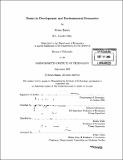Essays in development and environmental economics
Author(s)
Hanna, Rema
DownloadFull printable version (8.593Mb)
Other Contributors
Massachusetts Institute of Technology. Dept. of Economics.
Advisor
Michael Greenstone and Esther Duflo.
Terms of use
Metadata
Show full item recordAbstract
This thesis is a collection of three empirical essays on economic development and environmental economics. Chapter 1 measures the response of U.S. based multinational firms to the Clean Air Act Amendments (CAAA), which dramatically strengthened U.S. environmental regulation. Using a panel of firm-level data over the period 1966-1999, I estimate the effect of regulation on a multinational's foreign production decisions. The CAAA induced substantial variation in the degree of regulation faced by firms, allowing for the estimation of econometric models that control for firm-specific characteristics and industrial trends. I find that the CAAA caused regulated multinational firms to increase their foreign assets by 5.3% and their foreign output by 9%. In aggregate, this increase represents approximately 0.6% of the stock of multinationals' domestic assets in polluting industries. Contrary to common beliefs, I find that heavily regulated firms did not disproportionately increase foreign investment in developing countries. Finally, this paper presents limited evidence that U.S. based multinationals increased imports of highly polluting goods when faced with tougher U.S. environmental regulation. Overall, these results are consistent with the view that U.S. environmental regulations cause U.S. firms to move capital and jobs abroad. (cont.) Chapter 2 looks at the teacher absence. In the rural areas of developing countries, teacher absence is a widespread problem. This paper tests a simple incentive program based on teacher presence can reduce teacher absence, and whether this has the potential to lead to more teaching activities and better learning. In 60 one-teacher informal schools in rural India, randomly chosen out of 120, a financial incentive program was initiated to reduce absenteeism. Teachers were given a camera that had a temper-proof date and time function, along with instructions to have one of the children photograph the teacher and other students at the beginning and end of the school day. The time and date stamps on the photographs were used to track teacher attendance. A teacher's salary was a direct function of his attendance. The introduction of the program resulted in an immediate decline in teacher absence. The absence rate changed from an average of 42% in the comparison schools to 22% in the treatment schools. When the schools were open, teachers were as likely to be teaching in both types of schools, and the number of students present was roughly the same. (cont.) The program positively affected child achievement levels: A year after the start of the program, test scores in program schools were 0.17 standard deviations higher than in the comparison schools and children were more likely to be admitted into regular schools. Chapter 3 estimates the labor supply effect of childbirth for Jewish and Muslim women in Israel. As a source of exogenous variation in childbirth I use preferences over the gender composition of children, which vary across the two cultural groups. While Israeli Arabs prefer sons, Israeli Jews have a relative taste for symmetric families (at least one son and one daughter). Highly educated Arabs and Jews appear to prefer small families, but are significantly more likely to have another child if they only have daughters. Using this exogenous variation in fertility, I find that Jewish women work less as a result of having a third child. Arabs work less as result of having a third child; however, this decrease is not significant at conventional levels. When extending the analysis to look at the labor supply response to a fourth child, I find that Jewish women are less likely to work with an additional child, whereas Muslim women are more likely to be employed. However, religious institutions may not be fully responsible for these differences in behavior. (cont.) Instead, other socioeconomic characteristics may attribute to the observed differences in the labor supply response across religious groups.
Description
Thesis (Ph. D.)--Massachusetts Institute of Technology, Dept. of Economics, 2005. Includes bibliographical references.
Date issued
2005Department
Massachusetts Institute of Technology. Department of EconomicsPublisher
Massachusetts Institute of Technology
Keywords
Economics.